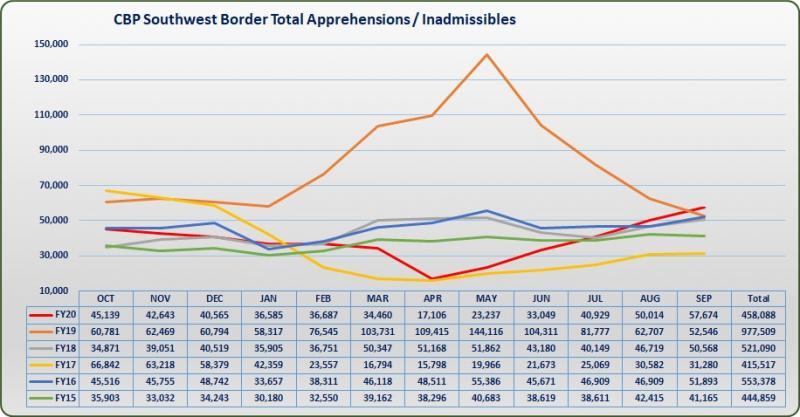Border agents apprehended nearly half-a-million illegal aliens during fiscal 2020, U.S. Customs and Border Protection reported in the last of its monthly updates for the year.
For the year ending September 30, agents caught 458,088, which is less than half the more than 950,000 apprehended last year.
In September, almost 60,000 landed in custody.
Though the annual total is substantially less than fiscal 2019, the data also show an ominous trend. The number of illegals apprehended monthly in 2020, after heading downward after peaking in May 2019, began rising steadily 12 months later.

Apprehensions Increased Across All Categories
The number of illegals caught trying to jump the border increased from last month across all three subcategories CBP includes in its data.
The number of unaccompanied children increased 25.3 percent to 3,756 for a year-end total of 30,557.
Family units increased 46 percent, 2,609 to 3,808. Total for the year was 52,230.
Single adults, consistently the largest category, increased 13.2 percent from 41,676 to 47,207.
The number of single adults who crossed the border could fill a mid-size American city: 317,864.
Border Apprehensions — August / September / Year
• Unaccompanied Children — 2,998 / 3,756 / 30,557
• Family Units — 2,609 / 3,808 / 52,230
• Single Adults — 41,676 / 47,207 / 317,864
• Totals — 47,283 / 54,771 / 400,651
Inadmissibles, meaning those apprehended at ports of entry, increased from August in two of the four categories.
Unaccompanied children rose from 105 to 127, or 21 percent, for a year-end total of 2,682.
Single adults increased 7.6 percent, from 2,419 to 2,603. That category’s total for fiscal 2020 was 35,304.
The other two categories, “family units” and accompanied minor children, decreased. Border agents apprehended 18,764 illegals who claimed to be in families.
Many “family units” turn out to be nothing of the kind, as The New American has reported.
Inadmissibles — August / September / Year
• Unaccompanied Alien Children — 105 / 127 / 2,682
• Family Units — 106 / 86 / 18,764
• Single Adults —2,419 / 2,603 / 35,304
• Accompanied Minor Child — 101 / 87 / 607
Totals — 2,731 / 2,903 / 54,437
Totals for Both Categories — 50,014 / 57,674 / 458,088
Added together, both broad categories — inadmissibles and border apprehensions — were 57,674 for September and 458,088 for the year.
The total this year is 46 percent of fiscal 2019’s 977,509, when border agents caught 2,678 illegal every day, or more than 111 per hour every 24 hours.
The deluge overwhelmed agents and holding facilities.
In fiscal 2020, average daily apprehensions were 1,255, a relatively small 52 per hour.
2019 / 2020
October — 60,781 / 45,139
November — 62,469 / 42,643
December — 60,794 / 40,565
January — 58,317 / 36,585
February — 76,545 / 36,687
March — 103,731 / 34,460
April — 109,415 / 17,106
May — 144,116 / 23,237
June — 104,311 / 33,049
July — 81,777 / 40,929
August — 62,707 / 50,014
September — 52,546 / 57,674
Totals — 977,509 / 458,088
Increasing Again
Last year’s illegal immigration wave peaked at 144,116 in May, then dropped steadily to less than 20,000 in March, largely due, apparently, to the Chinese Virus pandemic.
But then the number began rising again, as illegals ignored President Trump’s immediate deportation order and began breaching the border in large numbers again.
September’s 57,674 apprehensions were more than three times April’s, which dropped below 18,000. September’s total more than doubled May’s.
Bad as that news is, however, governments across the region say they won’t allow any more “caravans” to assemble and march north to storm the U.S.-Mexico border — at least as long as the Chinese Virus pandemic remains a threat.
In October, Guatemala turned back a 1,000-strong horde of mostly Hondurans who tried to cross its border.
Though members of the COVID Caravan demanded their right to “go on,” Guatemalan authorities instead provided transportation back to Honduras.



